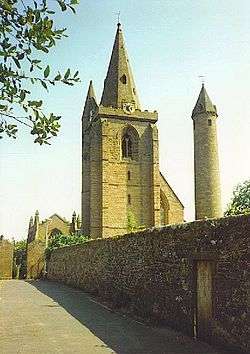Brechin Cathedral
Brechin Cathedral dates from the 13th century. As a congregation of the Church of Scotland, which is Presbyterian, the church is not technically a cathedral, in spite of its name.
| Brechin Cathedral | |
|---|---|
 The Cathedral and Round Tower | |

| |
| Location | Brechin |
| Denomination | Church of Scotland |
| Churchmanship | Reformed |
| Website | brechincathedral |
| Administration | |
| Presbytery | Presbytery of Angus |
| Laity | |
| Organist(s) | Ian Robertson |
It is in the Pointed style, but suffered maltreatment in 1806 at the hands of restorers, whose work was subsequently removed during the restoration completed in 1902. The western gable with its flamboyant window, Gothic door and massive square tower, parts of the (much truncated) choir, and the nave pillars and clerestory are all that is left of the original edifice. The modern stained glass in the chancel is reckoned amongst the finest in Scotland.
The cathedral is a category A listed building[1] and the attached Round Tower is a scheduled monument.[2]
Round Tower
Immediately adjoining the cathedral to the southwest stands the Round Tower, built about 1000 A.D. It is 86 ft.(26.21 m) high, has at the base a circumference of 50 ft.(15.3 m) and a diameter of 16 ft.(4.9 m), and is capped with a hexagonal spire of 18 ft.(5.5 m), added in the 14th century. This type of structure is somewhat common in Ireland, but the only Scottish examples are those at Brechin and Abernethy in Perthshire.
The quality of the masonry is superior to all but a very few of the Irish examples. The narrow single doorway, raised some feet above ground level in a manner common in these buildings, is also exceptionally fine. The door-surround is enriched with two bands of pellets, and the monolithic arch has a well-preserved representation of the Crucifixion. The slightly splayed sides of the doorway (also monolithic) have relief sculptures of ecclesiastics, one of them holding a crosier, the other a Tau-shaped staff.
Two monuments preserved within the cathedral, the so-called 'Brechin hogback', and a cross-slab, 'St. Mary's Stone' are further rare and important examples of Scottish 11th century stone sculpture. The hogback combines Celtic and Scandinavian motifs, and is the most complex known stone sculpture in the Ringerike style in Scotland. The inscribed St Mary's Stone has a circular border round the central motif of the Virgin and Child which echoes that on the Round Tower.
Gallery
.jpg) Stained glass: The crucifixion (1902, Henry Holiday)
Stained glass: The crucifixion (1902, Henry Holiday) Stained glass window
Stained glass window Historical view in 1727
Historical view in 1727 Interior
Interior The Brechin Hogback
The Brechin Hogback Doorway
Doorway Exterior
Exterior Historic view
Historic view
See also
References
- Historic Environment Scotland. "BRECHIN CATHEDRAL CHURCH LANE. (Category A) (LB22439)". Retrieved 26 February 2019.
- Historic Environment Scotland. "Brechin Cathedral Round Tower (SM90041)". Retrieved 26 February 2019.
- Brechin Cathedral and Round Tower, Lumina Technologies, July, 2005
![]()
External links
| Wikimedia Commons has media related to Brechin Cathedral. |